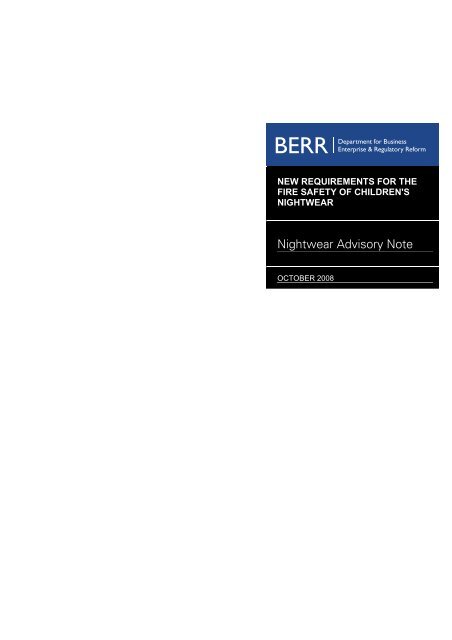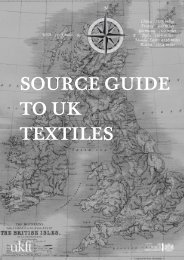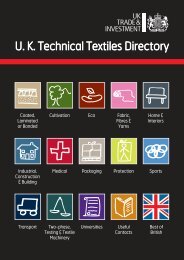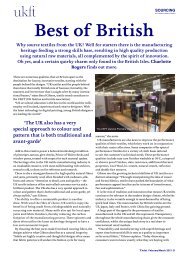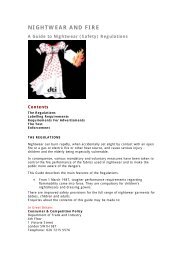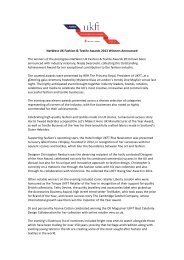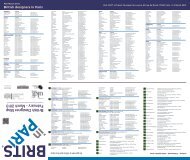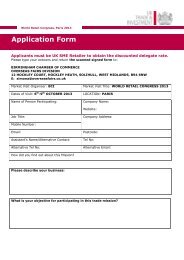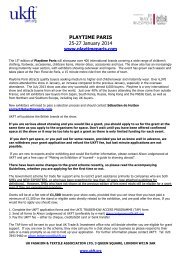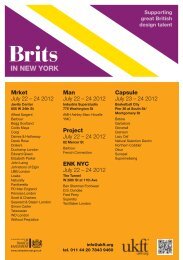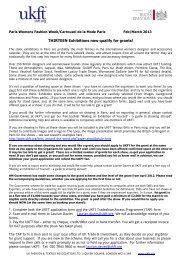Childrens Nightwear Advisory Note - Dius.gov.uk
Childrens Nightwear Advisory Note - Dius.gov.uk
Childrens Nightwear Advisory Note - Dius.gov.uk
Create successful ePaper yourself
Turn your PDF publications into a flip-book with our unique Google optimized e-Paper software.
NEW REQUIREMENTS FOR THE<br />
FIRE SAFETY OF CHILDREN'S<br />
NIGHTWEAR<br />
<strong>Nightwear</strong> <strong>Advisory</strong> <strong>Note</strong><br />
OCTOBER 2008
<strong>Nightwear</strong> <strong>Advisory</strong> <strong>Note</strong> Final Version.doc<br />
NEW REQUIREMENTS FOR THE FIRE SAFETY OF CHILDREN'S NIGHTWEAR<br />
This is an advisory note regarding new flammability performance requirements for children's<br />
nightwear introduced by the European standard: BS EN 14878 Textiles - Burning behaviour of<br />
children's nightwear - Specification, which comes into effect in November 2008.<br />
Children's nightwear in the UK must comply with the <strong>Nightwear</strong> (Safety) Regulations 1985 ("the UK<br />
Regulations"), and continue to do so even after November. On the whole, the flammability<br />
performance requirements of the UK Regulations are more stringent than those set out in the new<br />
European Standard. However, there are some requirements of BS EN 14878 that are a little more<br />
onerous or which are different to those prescribed in the UK Regulations.<br />
This note sets out the differences between these two sets of requirements and gives guidance on how<br />
to ensure that products comply with both.<br />
However, this <strong>Advisory</strong> <strong>Note</strong> is a guide compliance with the statutory requirements only. It is<br />
not a definitive explanation of the law. If in doubt about whether a product satisfies the<br />
legislative requirements, you should seek legal advice.<br />
Key Differences between BS EN 14878 and the <strong>Nightwear</strong> (Safety) Regulations 1985<br />
1. BS EN 14878 covers nightwear garments, and fabrics intended for nightwear for babies and<br />
children from birth up to age 14 years only. The UK Regulations apply to nightwear for<br />
children up to age 13 and adults, and all garments for babies.<br />
2. BS EN 14878 defines a baby as up to 6 months and up to a height of 68 cm; the UK<br />
Regulations define a baby as a child under the age of 3 months and give no height limit.<br />
3. For pyjamas: BS EN 14878 includes two levels of fabric performance for flammability,<br />
dependent upon the garment styling. While these performance requirements are low by<br />
comparison with the UK Regulations, they will nevertheless eliminate the most hazardous<br />
fabrics and design combinations.<br />
4. For bath robes: BS EN 14878 does not distinguish between bath robes and dressing gowns in<br />
setting flammability performance requirements. This reflects changing consumer behaviour.<br />
The UK Regulations exempt cotton terry bath robes from the flammability performance<br />
requirements (although there are compulsory labelling requirements).<br />
5. For other nightwear garments such as nightdresses and dressing gowns (but not cotton terry<br />
towelling bath robes) the requirements of the UK Regulations are more onerous than BS EN<br />
14878.<br />
6. The test methods for assessing flammability performance for BS EN 14878 are different from<br />
those used under the UK Regulations, and results therefore cannot be directly compared.<br />
7. BS EN 14878 does not require specimens to be tested after washing (except to assess<br />
durability of applied flame retardant finishes). The UK Regulations require all specimens to be<br />
tested after washing.<br />
8. BS EN 14878 does not cover threads and trimmings, while the UK Regulations do.<br />
9. It is accepted that under the UK Regulations a garment which is wholly made of and trimmed<br />
with a synthetic fabric that on the application of heat melts without decomposing, complies<br />
with the flammability performance requirements. BS EN 14878 requires all fibre types to be<br />
assessed.<br />
Page 1 of 9
<strong>Nightwear</strong> <strong>Advisory</strong> <strong>Note</strong> Final Version.doc<br />
10. BS EN 14878 includes a toxicity assessment for all applied flame retardants such as those<br />
which might be applied to cotton fabrics. The UK Regulations do not include any requirements<br />
for assessing flame retardants.<br />
11. BS EN 14878 does not specify a minimum performance requirement to assess durability of<br />
flame retardants, only that they must be durable "for the expected life time of the garment"<br />
according to "normal washing procedures to which the garment could reasonably be expected<br />
to be subjected".<br />
12. Labelling is compulsory under the UK Regulations. Labels must meet strict criteria, including<br />
legibility and durability of text. Under BS EN 14878, labelling is optional but if taken, the text to<br />
be used is prescribed.<br />
13. The UK Regulations include specific requirements for advertisements for children's nightwear,<br />
while advertising is not mentioned in BS EN 14878.<br />
14. The General Product Safety Regulations 2005 (GPSR), under which BS EN 14878 can be<br />
used to assess safety of products, apply for the lifetime of the product, i.e. to new and<br />
second-hand products. The UK Regulations do not apply to second-hand garments.<br />
Summary<br />
BS EN 14878 concerns nightwear and fabrics intended as nightwear for babies and children up to age<br />
14. The major differences between this standard and the UK Regulations are that the standard has<br />
performance requirements for pyjamas and bath robes, as well as a requirement for a toxicology<br />
assessment of applied flame retardant finishes. These topics should also be considered as part of the<br />
risk assessment process (which is required under the GPSR) in addition to the UK Regulations. A few<br />
requirements of BS EN 14878 contradict the UK Regulations, while others are less onerous, leading<br />
to the possibility of less safe garments for children.<br />
In addition, the GPSR require second-hand products to be as safe as new products, but the UK<br />
Regulations do not apply to second-hand garments.<br />
There are no flammability requirements for babies' daywear and adult's nightwear in BS EN 14878,<br />
and such garments should continue to comply with the UK Regulations (under which there is an<br />
optional flammability requirement and a compulsory labelling requirement).<br />
Recommended Practice from end November 2008 onward<br />
In order to comply with the <strong>Nightwear</strong> (Safety) Regulations 1985 and BS EN 14878 it is recommended<br />
that the following be adopted:<br />
Page 2 of 9
<strong>Nightwear</strong> <strong>Advisory</strong> <strong>Note</strong> Final Version.doc<br />
Performance & Labelling<br />
Pyjamas<br />
Category Of Intended Wearer UK Performance Requirements Labelling Text<br />
Birth up to (6 months)<br />
height 68cm<br />
Over 68cm (6 months) and up<br />
to height:<br />
Girls 176cm (14 years)<br />
Boys 182cm (14 years)<br />
None<br />
Meet BS EN 14878 EITHER<br />
Class A<br />
When tested to BS EN 1103<br />
• no surface flash flame<br />
• 520mm trip thread severed<br />
in not less than 15s<br />
• no design limitations<br />
OR<br />
Class B<br />
When tested to BS EN 1103<br />
• no surface flash flame<br />
• 520mm trip thread severed<br />
in not les than 10s<br />
• with design limitations see<br />
BS EN 14878 clause 10<br />
KEEP AWAY FROM FIRE<br />
KEEP AWAY FROM FIRE<br />
Page 3 of 9
<strong>Nightwear</strong> <strong>Advisory</strong> <strong>Note</strong> Final Version.doc<br />
Night Dresses, Dressing Gowns<br />
Bath Robes (not cotton terry towelling)<br />
and similar garments<br />
Category Of Intended Wearer UK Performance Requirements Labelling Text<br />
Birth up to 3 months None KEEP AWAY FROM FIRE<br />
Over 3 months and<br />
up to height 68cm (6 months)<br />
Meet UK regulations, BS 5722:<br />
when tested to BS 5438<br />
• 300mm trip thread severed<br />
in not less than 25s<br />
and<br />
• 600mm trip thread severed<br />
in not less than 50s<br />
KEEP AWAY FROM FIRE<br />
LOW FLAMMABILITY TO<br />
BS 5722<br />
Over 68cm (6 months) and<br />
up to height<br />
Girls 176cm (14 years)<br />
Boys 182cm (14 years)<br />
Meet UK regulations, BS 5722:<br />
when tested to BS 5438<br />
• 300mm trip thread severed<br />
in not less than 25s<br />
and<br />
• 600mm trip thread severed<br />
in not less than 50s<br />
KEEP AWAY FROM FIRE<br />
LOW FLAMMABILITY TO<br />
BS 5722<br />
Bath Robes made of cotton terry towelling only<br />
Category Of Intended Wearer UK Performance Requirements Labelling Text<br />
Birth up to 3 months None KEEP AWAY FROM FIRE<br />
Over 3 months and<br />
up to 6 months<br />
Over 68cm (6 months) and<br />
up to height<br />
Girls 176cm (14 years)<br />
Boys 182cm (14 years)<br />
None<br />
Meet BS EN 14878<br />
Class A<br />
When tested to BS EN 1103<br />
• no surface flash flame<br />
• 520mm trip thread severed<br />
in not less than 15s<br />
KEEP AWAY FROM FIRE<br />
KEEP AWAY FROM FIRE<br />
The following remain unchanged and should be as defined in the UK <strong>Nightwear</strong> (Safety) Regulations<br />
1985:<br />
• Position of label in the garment<br />
• Font, size and colour of print<br />
• Label durability<br />
• Permanency of labelling of garment<br />
Page 4 of 9
<strong>Nightwear</strong> <strong>Advisory</strong> <strong>Note</strong> Final Version.doc<br />
Applied Flame Retardants<br />
Toxicology<br />
Where applied flame retardant finishes are used, only those approved by the EU Scientific Committee<br />
on Health and Environmental Risks (SCHER) should be used.<br />
If there is an absence of such approved finishes by SCHER (which is the case at the time of writing<br />
this note), another means of toxicological assessment of the flame retardant, which includes toxicity<br />
and eco-toxicity, could be adopted, for example:<br />
• during manufacture of the finish and its application, including any other chemicals used during<br />
application;<br />
• for the user, considering the user may be a baby who might suck and ingest the finish, or will<br />
have more sensitive skin which may be sensitised;<br />
• for disposal of garment at the end of its life via land fill or incineration.<br />
Durability<br />
Finishes must be durable for the lifetime of the garment when cleansed by the recommended<br />
methods.<br />
At a minimum, garments with these finishes should be durable to 12 repeat washes according to BS<br />
5651:1978 Specification for cleansing and wetting procedures for use in the assessment of the effect<br />
of cleansing wetting on the flammability of textile fabric and fabric assemblies, and meet the<br />
flammability performance requirements of BS EN 14878 or the UK Regulations as appropriate.<br />
Labelling<br />
All garments with an applied flame retardant finish should be labelled as currently required by the UK<br />
Regulations, i.e. "DO NOT WASH AT MORE THAN 50°C. CHECK SUITABILITY OF WASHING<br />
AGENT" This text, in black letters should be placed below the fire warning text.<br />
<strong>Note</strong>: suitable washing agents or laundry detergents carry information on the packet labels.<br />
Second-Hand <strong>Nightwear</strong> (Pre-Worn and Washed Garments)<br />
While the UK Regulations state that the legislation does not apply to second-hand nightwear, the<br />
GPSR clearly require all products to be safe for the life time of the product.<br />
Experience has shown that most garments remain safe for the lifetime of the product. Provided the<br />
labelling meets the criteria above and the wording is legible, garments may be sold second-hand.<br />
However, for fabrics treated with a flame retardant, the situation is less clear because the degree of<br />
adherence by previous users to laundry recommendations is obviously unknown. Any garment likely<br />
to have been treated with a flame retardant should therefore be destroyed and not offered for sale. No<br />
second-hand garments bearing the words 'DO NOT WASH AT MORE THAN 50°C. CHECK<br />
SUITABILITY OF WASHING AGENT' should be offered for sale (suggested as a pragmatic solution<br />
to the implications of the GPSR).<br />
* * *<br />
Background to the UK Regulations and BS EN 14878<br />
UK accident data shows a significant reduction in the occurrence of serious injuries resulting from<br />
accidental ignition of nightwear since the introduction of the UK Regulations.<br />
Other European countries (apart from Ireland) lack similar legislation. However, a number of serious<br />
injuries in Europe prompted the European Commission to ask CEN (the European standards making<br />
body) to investigate the feasibility of developing a Europe-wide standard for flammability of nightwear.<br />
This was intended to be used to demonstrate fire safety of nightwear in the context of the safety<br />
requirements of the General Product Safety Directive (Directive 2001/95/EC) which requires<br />
Page 5 of 9
<strong>Nightwear</strong> <strong>Advisory</strong> <strong>Note</strong> Final Version.doc<br />
producers to place only safe products on the market. It was intended that compliance with this new<br />
European nightwear standard would confer the presumption of safety in the context of the safety<br />
requirements of the GPSD (enacted in the UK as the General Product Safety Regulations 2005<br />
(“GPSR”)). Following CEN's subsequent study - which included UK input through the British<br />
Standards Institution - CEN agreed that such a standard was feasible. As a result, the Commission<br />
issued a mandate to CEN to develop “a specification for safe nightwear to cover burning<br />
characteristics and toxicology of applied flame retardant finishes”. After lengthy debate, this was<br />
published by CEN as 'EN 14878:2007 Burning Behavior of Children’s <strong>Nightwear</strong> - Specification' in 30<br />
European countries, and implemented in the UK as BS EN 14878:2007.<br />
However, in relation to compliance with the safety requirements of the GPSD, some requirements of<br />
BS EN 14878 are weaker than those in the UK Regulations; consequently the UK was obliged to<br />
enter an “A Deviation”, to state that the UK's more onerous requirements remain and must be<br />
followed. This A Deviation was published as an annex in all European Member States' editions of the<br />
standard.<br />
On the other hand, in some respects BS EN 14878 is more onerous than the UK Regulations, or the<br />
requirements are different. So, on the basis that the UK is obliged to meet the safety requirements of<br />
the GPSD, it is recommended that UK producers to do so by meeting the relevant requirements of BS<br />
EN 14878.<br />
The General Product Safety Regulations 2005<br />
The General Product Safety Regulations 2005 (GPSR) require all products intended for consumers or<br />
likely to be used for consumers to be safe or to pose only the minimum of risk compatible with the<br />
product's use -<br />
• under normal use and foreseeable use<br />
• for the lifetime of the product.<br />
The GPSR affect all persons who are involved as producers or distributors of products, in this<br />
case nightwear. It should be noted that the terms "producers" and "distributors" have particular<br />
meanings and responsibilities, as explained in the BERR Guide to the GPS Regulations (see Further<br />
Information below), but in effect, this includes everyone involved in the manufacture and supply of<br />
nightwear whose actions may affect the safety properties of nightwear.<br />
The GPSR provide no specific requirements for determining safety or "acceptable risk": it is the<br />
responsibility of the manufacturer, retailer, importer etc to decide. In general, a product is presumed to<br />
conform to the general safety requirement if:<br />
• it is in compliance with national legislation setting out specific safety requirements in order to<br />
be marketed in the UK (e.g. The <strong>Nightwear</strong> (Safety) Regulations 1985), or<br />
• it conforms to a voluntary national standard which gives effect to a European standard, the<br />
reference to which has been published in the Official Journal in accordance with Article 4 of<br />
the GPSD. It is worth noting that standard EN 14878 has not yet been referenced in the<br />
Official Journal.<br />
Where either of these circumstances does not exist or if they do not cover specific aspects of safety,<br />
then the safety of a product will be assessed taking into account :<br />
• any voluntary standard of the UK giving effect to a EU standard other than one referred to<br />
above e.g. BS EN 14878 Burning Behavior Of Children’s <strong>Nightwear</strong> Specifications<br />
• other national standards<br />
• recommendation of the European Commission setting guidelines on product safety<br />
assessment<br />
• product safety codes of good practice<br />
• state of the art and technology<br />
• reasonable consumer expectations concerning safety<br />
Page 6 of 9
<strong>Nightwear</strong> <strong>Advisory</strong> <strong>Note</strong> Final Version.doc<br />
Hence, while compliance with BS EN 14878 is not compulsory, it is a recognised way of<br />
demonstrating a minimum level of safety of the product for flammability.<br />
In principle, it is recommended that the more onerous of the requirements of the UK Regulations and<br />
GPSR/BS EN 14878 should be applied to children's nightwear in order to meet the statutory<br />
requirements of the GPSR and the UK Regulations.<br />
Frequently asked questions<br />
Q1. Where can I get my nightwear tested to ensure it meets the necessary requirements?<br />
A. You should have your products tested by a UKAS (United Kingdom Accreditation Service) or<br />
an equivalent test laboratory with accreditation to ISO 17025 where the accreditation body<br />
has mutual recognition with UKAS. A list of UKAS accredited laboratories can be obtained<br />
from UKAS, Tel: +44(0)20 8996 7001; www.<strong>uk</strong>as.com<br />
Q2. I am selling the same range of children's nightwear to the UK and European Markets;<br />
what flammability performance requirements do I need to meet?<br />
A. You must ensure any such product sold in the UK meets the flammability performance<br />
requirements of the UK Regulations 1985 and the safety requirements of the GPSR. To do<br />
this they should also meet the additional requirements of BS EN 14878 listed in this <strong>Advisory</strong><br />
<strong>Note</strong>. This will ensure the product can be sold in both the UK and the rest of Europe. *<br />
Q3. I am selling a range of nightwear in the UK and elsewhere in Europe. The UK <strong>Nightwear</strong><br />
(Safety) Regulations stipulate I label them in a specific manner but BS EN 14878 gives<br />
an alternative text for labels. What should I do?<br />
A. It is recommended that you use the labelling suggested in this <strong>Advisory</strong> <strong>Note</strong>. *<br />
Q4. I am exporting a range of nightwear for sale in Europe but not the UK; what<br />
requirements do I need to meet?<br />
A. You must ensure your products conform to the General Product Safety Directive and it is<br />
therefore recommended, as a minimum, they meet the requirements of BS EN 14878. *<br />
Q5. Will the UK <strong>Nightwear</strong> (Safety) Regulations be withdrawn at the end of the transition<br />
period mentioned in BS EN 14878?<br />
A. No. Compliance with the UK Regulations should mean safer garments for children. To rely on<br />
BS EN 14878 alone would be to adopt a significant reduction in safety of nightwear.<br />
The eighteen-month transition period given to retailers and manufacturers to clear their stocks<br />
of non-conforming product ends in November 2008. All garments must continue to meet the<br />
requirements of the UK Regulations from November 2008, and it is recommended garments<br />
also meet BS EN 14878 where its requirements are more onerous.<br />
Q6. What is an "A deviation"?<br />
A. A CEN member country may request an "A deviation" where it has pre-existing national<br />
legislation and the proposed EN standard sets a lower level of safety.<br />
The UK Regulations stipulate some requirements which are more onerous than EN 14878,<br />
consequently the UK requested an A deviation. The same text describing the A deviation<br />
appears in all Member States' editions of BS EN 14878.<br />
Q7. For several years I have been selling nightwear treated with a flame retardant. Should I<br />
have a toxicity check carried out?<br />
Page 7 of 9
<strong>Nightwear</strong> <strong>Advisory</strong> <strong>Note</strong> Final Version.doc<br />
A. While the nightwear may meet the flammability performance requirements of the UK<br />
Regulations, compliance with the GPSR is also required, for which the BS EN 14878 toxicity<br />
assessment clause is the simplest means of meeting the minimum requirements.<br />
Q8. My range of nightdresses is for age 13 and 14 years. Should the garments for 14 year<br />
olds comply with BS EN 1478 or the UK <strong>Nightwear</strong> (Safety) Regulations?<br />
A. Best practice is to apply the higher requirements of both BS EN 14878 and the UK<br />
Regulations to the whole range. This ensures neither manufacturers nor consumers are<br />
confused.<br />
Q9. Why does BS EN 14878 refer to the age and the height of a child?<br />
A. The age of the child indicates stage of development and normal expected behaviours, which<br />
is helpful in safety risk assessments. However, in most EU countries children's clothing is sold<br />
by height, not age.<br />
Q10. How do I check the pyjama design features?<br />
A. The retailer or manufacturer will know the size of child the garments are intended to fit. This<br />
will be documented on their size chart and be part of their garment style file. Comparison of<br />
the garment dimensions with this information will provide the design feature assessment.<br />
Q11. I carry out only one stage in the production process. Am I responsible for the fire<br />
safety of the garment?<br />
A. Producers, distributors or anyone in the supply chain is responsible for those aspects of<br />
safety of the product that their work affects.<br />
* Please note: a few European countries have adopted national industry agreements for nightwear flammability performance<br />
and labelling requirements. Advice should be sought from your legal or technical advisor for each country you are<br />
exporting to.<br />
Further Information<br />
For further information and advice, contact Trading Standards, your trade association, test houses<br />
who are accredited to UKAS, or BERR.<br />
BERR publishes the following guides on its website:<br />
• <strong>Nightwear</strong> and Fire - a guide to the <strong>Nightwear</strong> (Safety) Regulations<br />
http://www.berr.<strong>gov</strong>.<strong>uk</strong>/files/file25421.pdf<br />
• General Product Safety Regulations fact sheet: http://www.berr.<strong>gov</strong>.<strong>uk</strong>/consumers/factsheets/page38252.html<br />
and the BERR guide to the General Product Safety Regulations<br />
2005: http://www.berr.<strong>gov</strong>.<strong>uk</strong>/files/file22713.pdf<br />
Obtaining Legislation and Standards<br />
Legislation such as the General Product Safety Regulations (SI 1803 2005) can be downloaded from<br />
http://www.opsi.<strong>gov</strong>.<strong>uk</strong>.<br />
Copies of all legislation can be purchased from:<br />
The Stationery Office, PO Box 29, Norwich, NR3 1GN<br />
Tel: 0870 600 5522 Fax: 0870 600 5533 http://www.tso.co.<strong>uk</strong>/<br />
British Standards may be purchased from BSI British Standards: tel +44(0)20 8996 9001 or<br />
orders@bsi-global.com. Or visit www.bsi-global.com/british_standards<br />
Page 8 of 9
<strong>Nightwear</strong> <strong>Advisory</strong> <strong>Note</strong> Final Version.doc<br />
Applicable British Standards<br />
Please note that the UK Regulations refer to specific dated editions of the relevant British standards.<br />
Although these standards have been revised since the introduction of the UK Regulations, the older<br />
versions must be used in order to ensure product compliance.<br />
The UK Regulations:<br />
• BS 5722:1984 Flammability Performance of Fabric and Fabric Assemblies Used in<br />
Sleepwear and Dressing Gowns describes the performance requirements for UK<br />
regulations.<br />
• BS 5438:1976 Methods of test for Flammability of Vertically Orientated Textile Fabrics and<br />
Fabric Assemblies describes how to burn the fabrics for compliance with BS5722.<br />
• BS 5651:1978 Specification for Cleansing and Wetting Procedures for Use in the<br />
Assessment of the Effect Of Cleansing Wetting on the Flammability of Textile Fabric and<br />
Fabric Assemblies describes how to cleanse fabric prior to testing to BS 5438.<br />
The European standard:<br />
• BS EN 14878 Textiles - Burning Behaviour of Children’s <strong>Nightwear</strong> - Specification describes<br />
the requirements.<br />
• BS EN 1103 Textiles - Fabric For Apparel - Detailed Procedure for Determination of the<br />
Burning Behaviour describes how to burn fabrics for compliance with EN 14878.<br />
Enforcement<br />
1. The UK Regulations are safety regulations made under Section 11 of the Consumer<br />
Protection Act 1987.<br />
2. The UK Regulations are enforced by local trading authorities in England, Scotland and Wales,<br />
and in Northern Ireland by District Council Environmental Health Officers.<br />
3. Breach of the UK Regulations made under section 11 of the Consumer Protection Act 1987<br />
constitute offences under section 13 of that Act. This Act makes it an offence to "to supply,<br />
offer to supply, agree to supply, expose for supply or posses for supply" any children's<br />
nightwear not compliant with the UK Regulations. A person who commits an offence is<br />
currently liable to a summary conviction to imprisonment for a term not exceeding six months<br />
or a fine not exceeding £5000 or both.<br />
4. Under the General Product Safety Regulations 2005 it is an offence for:<br />
• a producer to place a product (in this case, nightwear) on the market or supply it (or<br />
undertake any of the preparatory acts to do either) unless the product is safe;<br />
• a distributor to expose or possess for supply, offer or agree to supply or supply a product<br />
(in this case, nightwear) which he knows or should have presumed, on the basis of the<br />
information in his possession and as a professional, is a dangerous product.<br />
For a person who commits a serious breach of the general safety requirement or the breach<br />
of a safety notice, the maximum penalty is a fine of £20,000 or 12 months imprisonment or<br />
both.<br />
For other offences the penalty is a maximum fine of £5,000 or 3 months imprisonment or<br />
both.<br />
Department for Business, Enterprise & Regulatory Reform. www.berr.<strong>gov</strong>.<strong>uk</strong><br />
First published October 2008. Crown Copyright. URN 08/1312<br />
Page 9 of 9


